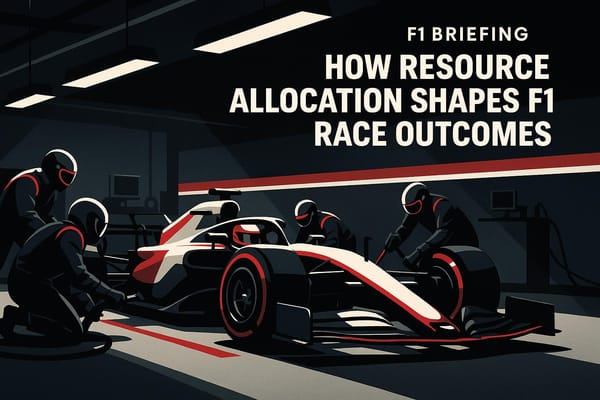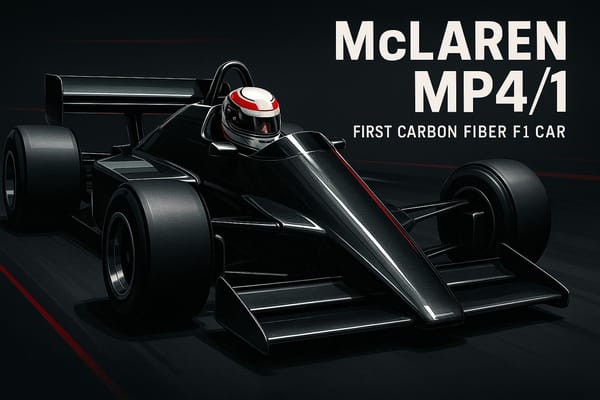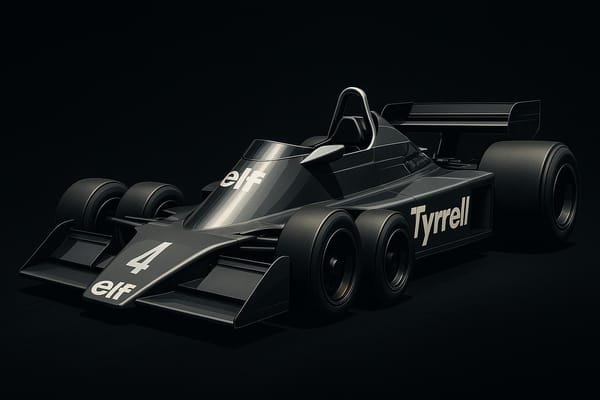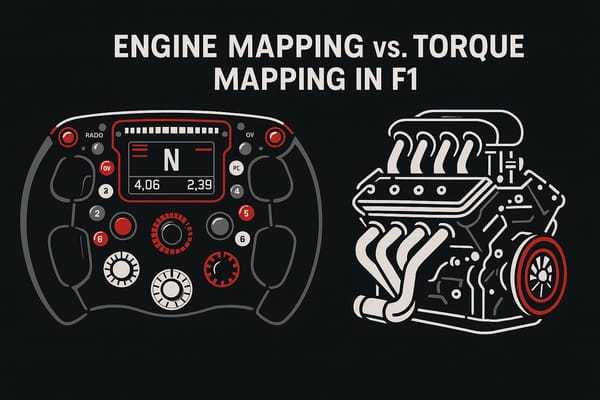How DRS Works in F1
Explore how the Drag Reduction System in Formula 1 enhances overtaking strategies and its evolution towards active aerodynamics in 2026.
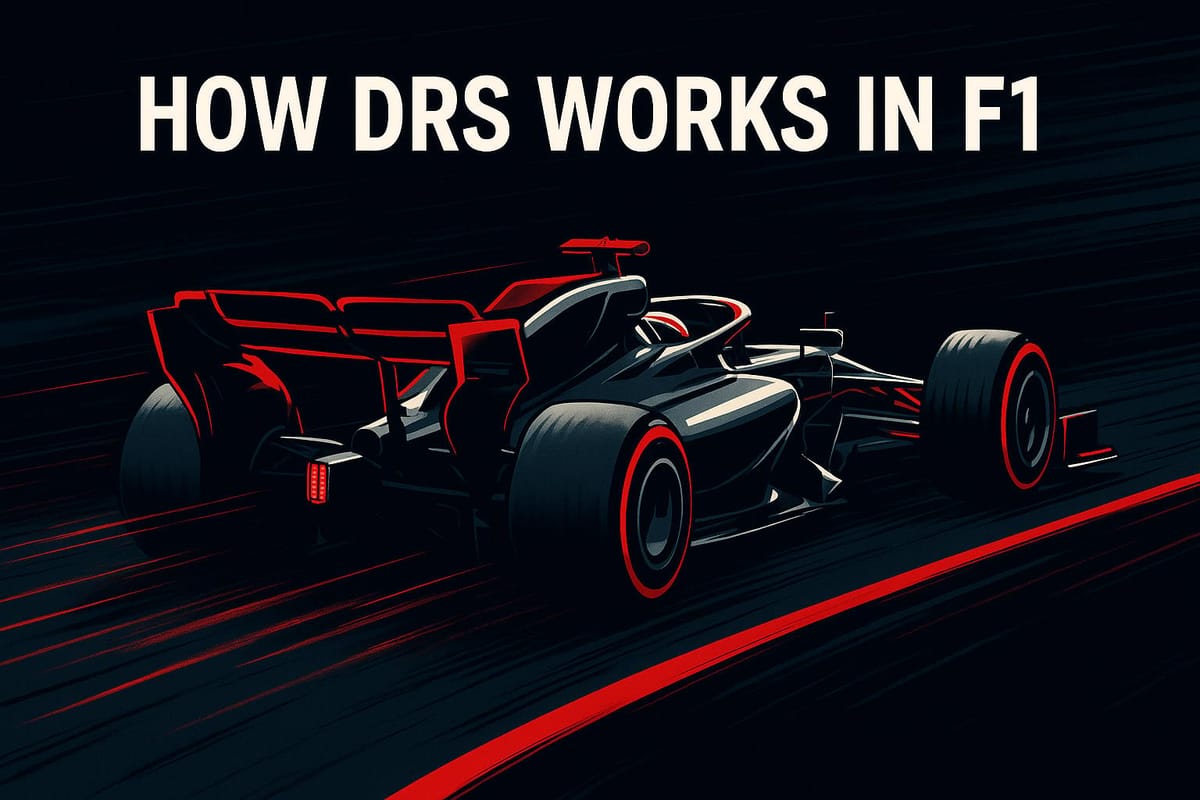
DRS (Drag Reduction System) is a tool in Formula 1 that helps drivers overtake by reducing aerodynamic drag and increasing straight-line speed. Introduced in 2011, it allows the rear wing flap to open in specific zones when the driver is within 1 second of the car ahead. Here's a quick breakdown:
- How It Works: Pressing a button opens the rear wing flap, reducing drag and boosting speed by 6-7 mph. However, this also reduces downforce, which is critical for cornering.
- Rules: DRS can only be used in designated zones, and not during the first lap, after safety car restarts, or in unsafe conditions like rain.
- Impact: DRS has significantly increased overtaking opportunities, but critics argue it sometimes makes overtaking too easy, reducing the skill involved.
- Future: In 2026, DRS will be replaced by active aerodynamics, allowing drivers more control over aerodynamic settings.
DRS has transformed racing strategies and car designs, adding excitement and unpredictability to F1. However, its role is evolving as the sport moves toward new technologies.
How Does DRS Work? | F1 TV Tech Talk | Crypto.com

How DRS Works: The Core Mechanics
To understand DRS, you need to know how its components - hydraulic, electronic, and aerodynamic - work in harmony to give drivers a performance edge at critical moments. At its core, the system revolves around the rear wing's ability to adjust dynamically, allowing for a significant boost in speed when needed.
Rear Wing Adjustment
The rear wing is the centerpiece of DRS, featuring an adjustable flap that creates its signature effect. This wing is made up of two main horizontal sections: a fixed main plane and a movable flap. The magic happens when the flap pivots at its trailing edge, opening a gap of up to 3.3 inches (85 mm) between itself and the main plane.
This adjustment reduces the wing's surface area, which in turn slashes aerodynamic drag. The trade-off? A loss of downforce, which is crucial for cornering. According to the FIA, this drag reduction can boost straight-line speeds by 6.2–7.5 mph (10–12 km/h), though other studies suggest a more modest increase of 2.5–3.1 mph (4–5 km/h).
"He will sprint down the straight and, by the end of it, will have a 4-5kph advantage over the car he is trying to pass", explains Tony Purnell, FIA advisor.
Safety is baked into the system's design. If there's a hydraulic or electronic failure, the flap will automatically return to its default high-downforce position, ensuring stability and control.
Activation Process
The process of activating DRS relies on a seamless interplay of electronic and hydraulic systems. When a driver presses the DRS button, it sends a signal to the ECU, which then activates the Moog valve responsible for triggering the hydraulic actuators. These actuators adjust the wing flap with precision.
"We have developed custom versions of our E024 series servo valve for rear wing actuation", says Martin Jones, Market Manager for European Motorsport at Moog.
The hydraulic system, composed of tubes, rods, and actuators, is designed to withstand the immense aerodynamic forces acting on the wing. Timing is everything when it comes to activation. Drivers must carefully judge the right moment to press the button, often as they exit a corner and cross the timing line within the designated interval.
"As a car comes out of a corner and crosses the timing line within the prescribed interval, at the moment the following driver feels he is no longer traction limited, he will press the button and drag on his rear wing will be reduced", explains Tony Purnell.
Once activated, the system stays open until the driver either lifts off the throttle, applies the brakes, or manually deactivates it by pressing the DRS button again.
Safety measures are also in place for deactivation. The system automatically closes the flap as soon as the driver begins braking for a corner, restoring the downforce needed for safe cornering. This ensures drivers maintain stability and grip, avoiding the dangers of reduced aerodynamic performance while navigating turns.
DRS Rules and Regulations
The FIA enforces strict regulations for DRS (Drag Reduction System) to maintain fairness and prioritize safety. These rules differ depending on whether it's a race or a practice session.
Race Conditions
In races, DRS operates under the one-second rule: a driver can only activate it if they are within one second of the car ahead at a designated detection point on the track. Drivers are notified of their eligibility through dash lights triggered at these detection points, which are strategically placed for each circuit. Once eligible, DRS can only be activated within the following activation zone.
There are additional restrictions during critical race moments. For example, DRS cannot be used on the first lap of a race, immediately after a safety car restart, or for the first two laps following a red flag restart. This ensures that overtaking opportunities remain controlled and safe during these high-pressure situations.
Defending drivers must follow the same rules - they can only activate DRS if they are within one second of a car in front. This often leads to scenarios where multiple cars in a line (commonly called a "DRS train") can simultaneously benefit from the system.
Weather conditions also play a role. If the track is deemed unsafe, such as during rain, the FIA race director can disable DRS entirely. This precaution ensures driver safety in unpredictable conditions.
Penalties for unauthorized DRS use are strict. Misuse is treated as a rule violation and can lead to significant consequences. A notable example occurred at the 2025 Bahrain Grand Prix on April 13, when George Russell of Mercedes activated DRS while chasing Oscar Piastri, despite not meeting the one-second requirement. Although Russell received a manual override due to timing issues, the incident was reported to the Stewards for investigation. He faced a potential five-second time penalty, which could have cost him a podium finish.
These rules strike a balance between allowing competitive overtaking and maintaining safety, while providing a contrast to the more relaxed regulations during practice and qualifying.
Practice and Qualifying Sessions
In practice and qualifying sessions, the regulations for DRS are much more relaxed. Drivers can activate DRS freely within the designated activation zones, without needing to meet the one-second gap requirement. This freedom helps teams gather crucial data on aerodynamic performance and fine-tune their setups for both qualifying and race conditions.
Before 2013, DRS could be used anywhere on the track during qualifying. While this allowed teams to optimize their setups for qualifying, it sometimes led to compromises in race performance. To address this, the FIA introduced zone restrictions for qualifying as well, ensuring a more balanced approach between qualifying speed and race-day competitiveness.
The difference in rules across sessions has significant strategic implications. Teams must carefully balance their car setups to maximize DRS advantages during qualifying while ensuring the car remains competitive under the stricter DRS rules in races. Regardless of the session, the race director retains the authority to disable DRS entirely if conditions are deemed unsafe.
DRS Impact on Racing and Car Design
Since its debut in 2011, the Drag Reduction System (DRS) has reshaped Formula One by influencing both race strategies and car design. By reducing aerodynamic drag, DRS has become a game-changer, offering teams and drivers new ways to approach competition.
Aerodynamic Advantages
When activated, DRS opens the rear wing flap by up to 85 mm, significantly cutting drag and boosting straight-line speed. This speed advantage has profoundly impacted how teams approach race dynamics.
However, it’s not just about speed on the straights. Teams must carefully balance downforce to ensure optimal performance across a variety of track sections. This balancing act has pushed engineers to explore innovations like wing end plate optimization, ensuring cars remain competitive throughout the season.
Race Tactics and Planning
The aerodynamic edge provided by DRS has also transformed race-day strategies. Team directors estimate that DRS can shave up to 0.5 seconds off a lap time, making its use a critical component of race planning. Pit stop timings, on-track positioning, and tactical maneuvers are now often designed around maximizing DRS in the designated activation zones.
Drivers, too, have adjusted their tactics. Charles Leclerc once described how he strategically used DRS to gain an advantage:
"I was trying to be as clever as possible using the DRS as much as possible, so I was trying to brake early into Turn 1 just to be behind him at the DRS detection, and twice it worked out."
Timing is everything with DRS. A poorly executed move can result in missed overtaking opportunities or unfavorable track positions. Another challenge is the "DRS train" phenomenon, where multiple cars within one second of each other all gain the speed boost. This forces teams to rethink overtaking strategies in such scenarios.
Benefits and Drawbacks of DRS
While DRS brings exciting elements to racing, it also introduces challenges that teams must navigate. Here’s a breakdown of its strategic advantages and limitations:
| Benefits | Drawbacks |
|---|---|
| Creates more overtaking opportunities, enhancing the thrill of races | Can lead to "artificial" overtaking, reducing the emphasis on driver skill. Former F1 driver Juan Pablo Montoya likened it to "giving Picasso Photoshop" |
| Adds unpredictability and drama to the spectacle | Provides an uneven advantage to the chasing driver |
| Introduces new tactical layers for teams to exploit | Restricted to designated zones, limiting its flexibility |
| Promotes closer racing, enabling drivers to challenge each other more effectively | Risks overshadowing natural driver ability and traditional car performance |
| Increases passing statistics, as seen in record-breaking races | Reduces reliance on conventional overtaking methods |
The numbers back up DRS's influence. For instance, the 2016 Chinese Grand Prix featured 161 overtakes - the highest ever recorded in a dry race. That same season, Max Verstappen completed 78 overtakes, with 60 occurring while he raced for Red Bull.
However, DRS isn't without risks. Failures can lead to severe consequences, including black flag penalties or even disqualification. These potential setbacks force teams to prepare backup strategies, adding another layer of complexity to race-day planning.
DRS History and Future Changes
Since its introduction in 2011, DRS has transformed Formula One by making overtaking more achievable. Now, with active aerodynamics set to debut in 2026, the system's role will evolve as the sport aims to balance competitive racing with entertainment.
Introduction and Evolution
DRS was introduced in 2011 to tackle the overtaking difficulties caused by "dirty air" - a problem created by turbulent airflow behind cars. The system allows drivers within one second of the car ahead to reduce rear wing drag, increasing their speed on straights. Initially, DRS could be used anywhere during qualifying sessions, but safety concerns led to the introduction of designated activation zones. Over time, the system's specifications were adjusted to enhance its aerodynamic benefits.
Teams have continually pushed the boundaries of DRS technology. For instance, "double DRS" systems were developed to amplify performance but were later banned. In 2024, McLaren's flexible rear wing unintentionally mimicked DRS effects, prompting the FIA to enforce design changes. Speed gains from DRS have varied, with standout examples like Red Bull Racing's RB19 in 2023, which demonstrated how optimized aerodynamics can amplify its effectiveness.
These advancements have paved the way for the upcoming shift to active aerodynamic systems in 2026.
Future of Aerodynamics in F1
Looking at DRS's evolution helps explain why Formula One is moving toward active aerodynamics. In 2026, DRS will be replaced by a new system that gives drivers full control over their car's aerodynamic settings, eliminating the proximity-based activation model.
The new regulations will introduce Z-mode for high downforce during cornering and X-mode for low drag on straights. Drivers will be able to switch between these modes at specific points on the track, regardless of their position relative to other cars.
"With the 2026 car we'll be giving the drivers the ability to switch between the high downforce and low drag modes irrespective of any gaps." - Jason Somerville, FIA's head of aerodynamics
The active aerodynamic system will significantly alter car performance, reducing downforce by 30% and drag by 55%. Key changes include a narrower front wing (reduced by 100mm), a simplified two-element front wing flap, and a three-element rear wing. Cars will also be lighter, with a minimum weight of 768kg, down by 30kg.
Power unit advancements will further enhance performance. Battery output will rise from 120kW to 350kW, energy recovery will double to 8.5 MJ per lap, and a manual override engine mode will provide an additional 350kW, allowing speeds of up to 337 km/h with an extra 0.5MJ for overtaking.
Nikolas Tombazis, FIA Single Seater Technical Director, is optimistic about the impact of these changes:
"We believe the racing will be much more exciting and much closer between cars."
"Lighter, more powerful and more focused on driver skill, the 2026 FIA Formula One Technical Regulations have been designed to provide closer racing among drivers, increase the competition between teams and to improve the spectacle."
To ensure safety, the FIA is also considering rules to restrict X-mode use in wet conditions. Jan Monchaux highlighted the practicality of active aerodynamics:
"Every high-end premium car has active aero on the road and I think nowadays, thanks to technology, we are in a far better position than maybe 30 or 40 years ago to develop these systems in a safe and reliable manner."
The transition to active aerodynamics marks a major step forward, giving drivers more control while maintaining the close, strategic racing that DRS has helped define over the years. It’s a move that ties together the themes of overtaking strategy and downforce management that have been central to modern Formula One.
Conclusion
Since its introduction in 2011, DRS has left a lasting mark on Formula 1 by making overtaking more achievable. By offering a tangible speed boost, it has not only changed how drivers compete wheel-to-wheel but also influenced how teams approach race strategies.
DRS has done more than just make cars faster - it has redefined the dynamics of race strategy. Iconic moments, such as the record-breaking overtakes during the 2016 Chinese Grand Prix, highlight how it has reinvigorated on-track battles and showcased remarkable individual performances over the years.
Looking ahead, DRS has also laid the groundwork for future aerodynamic advancements. Over a decade of experience with adjustable aerodynamics has shaped the development of active aerodynamic systems set to debut in 2026. While DRS will be phased out, its influence will live on, having addressed the overtaking challenges of its time and paving the way for innovations like Z‑Mode and X‑Mode to keep the racing as thrilling as ever.
FAQs
How will active aerodynamics in 2026 differ from the current DRS system in Formula 1?
Starting in 2026, Formula 1 is set to introduce active aerodynamics, a game-changing feature that will completely transform how drivers manage their cars. Unlike the current Drag Reduction System (DRS), which is limited to specific zones and requires a driver to be within one second of the car ahead, active aerodynamics will allow drivers to adjust their front and rear wings dynamically at any point on straights. This added flexibility means drivers can fine-tune downforce and drag on the fly, opening up more opportunities for overtaking and adding new layers to race strategies.
What's even more exciting is how active aerodynamics will work alongside energy recovery systems. Drivers will have access to a "Manual Override" feature, letting them deploy extra energy during overtakes. This combination is expected to make races tighter and more thrilling by encouraging closer battles and reducing the dependence on designated DRS zones. It's a bold step forward in Formula 1 technology, promising to shake up race dynamics in a big way.
How does Formula 1 ensure DRS is safe to use in wet or hazardous conditions?
In Formula 1, the Drag Reduction System (DRS) is a tool aimed at making overtaking easier, but its use comes with strict safety measures. For instance, DRS is automatically disabled during wet conditions because the reduced grip on the track makes its use risky. Beyond that, the FIA race director has the authority to limit DRS activation in situations like poor visibility or other hazardous conditions to avoid creating dangerous speed differences between cars.
To maintain both safety and fairness, DRS can only be activated in designated zones and under dry track conditions. This ensures drivers can take advantage of it without losing control or increasing the risk of accidents while attempting overtakes.
How has DRS shaped car design and race strategies in Formula 1, and what challenges do teams face with its limitations?
Since it was introduced in 2011, the Drag Reduction System (DRS) has brought a new dimension to Formula 1, making overtaking more manageable and adding a strategic twist to the sport. By altering the rear wing to lower aerodynamic drag, DRS boosts straight-line speed, giving drivers a much-needed edge when attempting to pass a competitor. Teams have since tailored their car designs to capitalize on DRS, prioritizing aerodynamic efficiency. In fact, DRS can shave off as much as half a second per lap - an enormous advantage in a sport where every fraction of a second counts.
That said, DRS isn't without its drawbacks. One common issue is the formation of "DRS trains", where several cars, all using DRS, end up stuck behind one another, making overtaking no easier. Plus, since DRS can only be activated in specific zones on the track, teams must carefully craft their strategies to make the most of these opportunities. While DRS has undeniably reshaped Formula 1, these challenges continue to push teams and drivers to think creatively.

